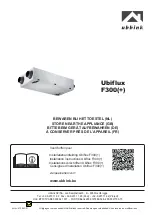30
Part No. 6-847684-00 Rev. D01
1. Identify each pair of field installed
source equipment signal wires inside
alarm panel back box assembly.
2. Route each pair of signal wires as
shown in Figure 21 to appropriate
multi-signal module.
3. Connect each pair of signal wires to
desired multi-signal module terminals.
The terminals are labeled “Signal 1”
through “Signal 5”. Signal 1
corresponds to top row of indicators
on front panel of multi-signal module.
Signal 5 corresponds to bottom row.
Refer to Figure 22.
4. Insert appropriate source equipment
label into multi-signal module front
panel as shown in Figure 23. A sheet
of common source equipment signals
has been provided for convenience.
Blank labels are also provided.
Finish Installation
Source Equipment Wiring
CAUTION:
Source equipment signal wires must be connect-
ed to normally-closed, dry contacts. No electrical
voltage can be present and contacts must be
closed during normal equipment operation. When
contacts open, an alarm condition will be activat-
ed.
NOTE:
Each pair of terminals labeled on the multi-signal
module connector is labeled “+” and “COM”.
Ensure that when a source equipment dry contact
is wired to two master panels, the same side of
the dry contact is connected to the same terminal
at both panels. For example, if the source equip-
ment’s normally closed contact is wired to the “+”
of the first master panel, ensure it is also connect-
ed to the “+” terminal of the second master panel.
3. Connect positive sensor wire to
terminal 5 and negative sensor wire to
terminal 6 for each remote sensor and
digital display module. Refer to Figure
19.
4. Blank digital display module location
labels are provided so each digital
display module may be identified with
area/zone that it is monitoring. Insert
location labels (if desired) as shown in
Figure 20.
Figure 19: Remote Sensor Wire Termination
Digital Display Module
From remote sensor
Pin 5 (+)
Pin 6 (-)
Figure 20: Digital Display Module
Remote Sensor Wiring
Label
(provided)
Slide label into slit in
front panel overlay


















